A Scion Society of The Baker Street Irregulars
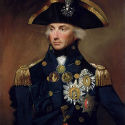
Arthur Conan Doyle and the HMS Foudroyant
“…my boy in the navy has cost me much.”
– A Study In Scarlet (STUD)
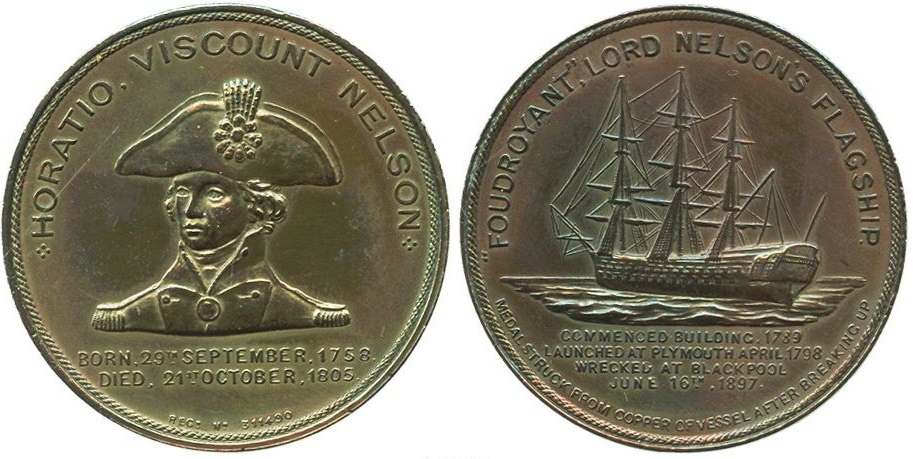 The 20th Garrideb, Dr. George A. Vanderburgh, shared this medal of Lord Horatio Nelson and the HMS Foudroyant with us.
The 20th Garrideb, Dr. George A. Vanderburgh, shared this medal of Lord Horatio Nelson and the HMS Foudroyant with us.
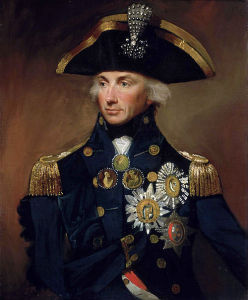 Horatio Nelson was born in 1758 and would join the Royal Navy at a young age. By the age of 20, he would assume the command of his own ship.
Horatio Nelson was born in 1758 and would join the Royal Navy at a young age. By the age of 20, he would assume the command of his own ship.
With the outbreak of the French Revolution, Nelson was active fighting the French navy in the Mediterranean Sea and became noted for his personal bravery and use of tactics. He would lose the sight of one eye and the loss of his right arm.
Nelson would be fatally wounded by a French sharpshooter during the Battle of Trafalgar, Britain’s greatest naval victory and would earn accolades and a place as one of Britain’s greatest heroes.
The HMS Foudroyant was an 80-gun ship of the Royal Navy that launched in June 1798. For two years, June 1799 until June 1801, the Foudroyant would serve as Lord Nelson’s flagship and served in active duty for 17 years. Until 1860, she would serve as a guard ship in Devonport and then as a gunnery training ship until 1884. In the early 1890’s, there were some efforts to dispose of the ship and at one point it was being sold to the Germans.
Arthur Conan Doyle had some strong opinions about the possibility of the sale of this ship to the Germans and penned the following poem that appeared in the September 12, 1892 edition of The Daily Chronicle:
H.M.S. “Foudroyant”
[Being an humble address to Her Majesty’s Naval advisers, who sold Nelson’s old flagship to the Germans for a thousand pounds.]
Who says the Nation’s purse is lean,
Who fears for claim or bond or debt,
When all the glories that have been
Are scheduled as a cash asset?
If times are bleak and trade is slack,
If coal and cotton fail at last,
We’ve something left to barter yet-
Our glorious past.
There’s many a crypt in which lies hid
The dust of statesman or of king;
There’s Shakespeare’s home to raise a bid,
And Milton’s house its price would bring.
What for the sword that Cromwell drew?
What for Prince Edward’s coat of mail?
What for our Saxon Alfred’s tomb?
They’re all for sale!
And stone and marble may be sold
Which serve no present daily need;
There’s Edward’s Windsor, labelled old,
And Wolsey’s palace, guaranteed.
St. Clement Danes and fifty fanes,
The Tower and the Temple grounds;
How much for these? Just price them, please,
In British pounds.
You hucksters, have you still to learn,
The things which money will not buy?
Can you not read that, cold and stern
As we may be, there still does lie
Deep in our hearts a hungry love
For what concerns our island story?
We sell our work – perchance our lives,
But not our glory.
Go barter to the knacker’s yard
The steed that has outlived its time!
Send hungry to the pauper ward
The man who served you in his prime!
But when you touch the Nation’s store,
Be broad your mind and tight your grip.
Take heed! And bring us back once more
Our Nelson’s ship.
And if no mooring can be found
In all our harbours near or far,
Then tow the old three-decker round
To where the deep-sea soundings are;
There, with her pennon flying clear,
And with her ensign lashed peak high,
Sink her a thousand fathoms sheer.
There let her lie!
Arthur Conan Doyle wrote a follow-up letter with his thoughts on the sale of the Foudroyant in the September 22, 1892 edition of The Daily Chronicle:
FOR NELSON’S SAKE
Sir, – I had waited in the hope that some one else would have answered “R.N.’s” letter, but I prefer to intrude upon your space a second time rather than to leave it unanswered. If your correspondent’s signature means that he is an officer of the Royal Navy, we may be allowed to hope that his seamanship is better than his logic. He states that our desire to save Nelson’s flagship for the nation shows that we are ignorant of naval history. Most people would have thought that it proved the contrary. If, as he states, others of Nelson’s ships have been sold in days gone by, surely the obvious deduction is that it is the more important that this one, almost a last survival, should be retained. As to Nelson’s mental or moral state during the time he commanded her, that is quite beside the question. The point is that we have only two ships that ever carried his flag, and that one of them has been sold for an insignificant sum to a foreign nation.
The talk of the expense of keeping the old ship up will not bear discussion. We must, as long as our Navy lasts, have store and depôt and receiving ships in our harbours. The Foudroyant can always earn her keep as one of those. Supposing that it takes £10,000 to give her a fresh lease of life. If we can afford £70,000 for an old master, we can also find money to preserve our national relics.
Yours faithfully,
A. CONAN DOYLE
12, Tennison-road, South Norwood.
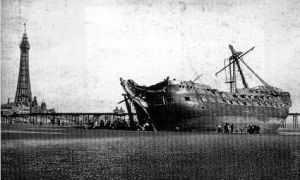 The public outcry was able to save the ship and the Foudroyant was converted into a boy’s training ship and would be exhibited at various seaside resorts to help recoup the expenses of refurbishing the ship.
The public outcry was able to save the ship and the Foudroyant was converted into a boy’s training ship and would be exhibited at various seaside resorts to help recoup the expenses of refurbishing the ship.
On June 16, 1897, the Foudroyant would break loose from her cables during a storm and went aground in Blackpool. Attempts to refloat the ship would fail and a decision was made to offload the cannon and sell them for scrap. In December of that year, the ship would break up during storms. Local craftsmen would make furniture from the floating wreckage.
In addition, metal was salvaged from the wreck and used to strike medals like the one at the top of this post. This was a common practice at the time and many different medals were probably struck as souvenirs. Below is another example of a relic medal from the Foudroyant.
Any other relic medals of the Foudroyant out there?

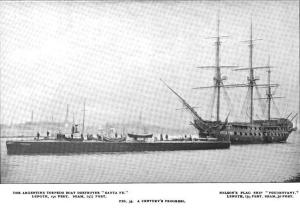
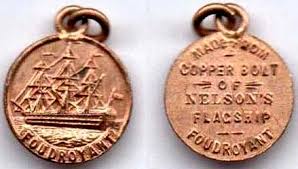
Greg and everyone, an interesting piece about Vice-Admiral Viscount Nelson of the Nile and Duke of Bronte. Actually very few people in Britain today would be able to tell you anything about him, history teaching today revolves around how Roman catholic people would think at the time of the Reformation. It is correctly termed ‘psycho-history’, and derives from the 1960s when the theory was that ‘all history is the history of the mind’. There is also among the elite in Britain a sense of guilt and self-loathing about everything this once great nation ‘did’ to our continental neighbours, and especially to the indigenous peoples of our Empire (shhh a dirty word now).
Greg just one little technical point, the Royal Navy is not the British Navy, but to this day is the English Navy, that is why the White Ensign has the flag of St.George depicted thereon (the St.Georges cross is another politically incorrect symbol today – many immigrants to the UK object to it being flown!) As you may imagine the poem Sir Arthur penned is also now Un-pc, it may upset our German partners you see, and we can’t have that can we?
Thanks for the comments Rodger! All references have now been modified to just read as the Royal Navy.
Greg, thank-you indeed, I shall drink a toast to the memory of the departed – seated of course.